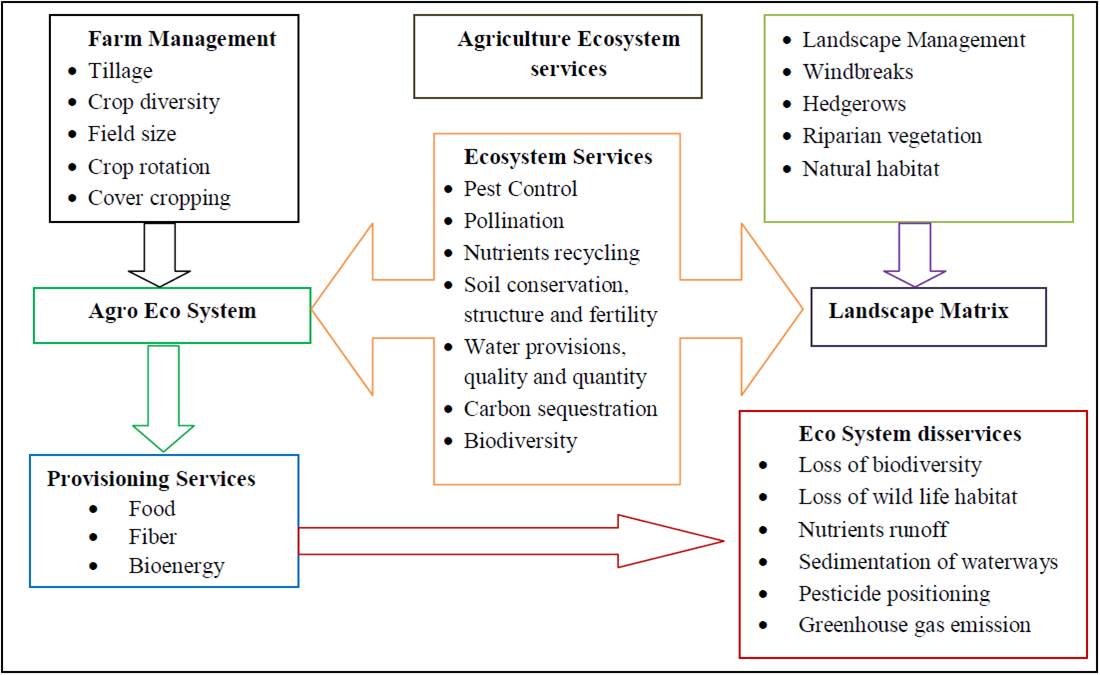|
Agricultural Ecosystem Services Paradigms
V iewed globally, agriculture is a dominant form of land management with agricultural ecosystems covering nearly 40 per cent of the terrestrial surface of the earth (FAO 2009). Agro-ecosystems can provide a range of regulating and cultural services to human communities in addition to provisioning services and services which support provisioning. Regulation of services obtained from agriculture may embrace flood control, carbon storage, water quality control and climate regulation through greenhouse gas emissions, disease regulation and waste treatment (e.g. of nutrients and pesticides). Cultural services will include scenic beauty, education, recreation and tourism. Agricultural places and products are often used in traditional rituals and customs that bond human communities together. Conservation of biodiversity may also be considered a cultural ecosystem service influenced by agriculture since in most cultures appreciation of nature is recognised as an explicit human value. In return, biodiversity can contribute a variety of supporting services to agro-ecosystems and surrounding ecosystems (Daily 1997).Ecosystem services in agriculture include biological pest control, pollination, water quantity and quality, soil structure and fertility as well as landscape influences on the delivery of ecosystem services to agriculture. |
|
Benefits of farm ponds or "earth bottom" ponds are many, as can be seen from the list below:· • Water from farm ponds serves as a backup for irrigation ·• Livestock can also drink the pond water and this is important as animals provide an alternate source of livelihood·• Ponds also provide a holding place for runoff water from surrounding areas thus harvesting rainwater.• Ponds maintain a self-sustaining cycle of hydration that keeps plants alive. |
|
Some years ago many families living in village Khaurgarh of Shivpuri district (M.P.) were facing the problem of water scarcity for irrigation as the ground water level had drastically dropped from 20 ft to 250 ft and was further going down owing to over exploitation, peculiar relief features of the terrain and the semi-arid and drought prone climate of the area. One of the families decided to take the matter in their hands and improve the management of water in the village. They had already spent a lot of money on electricity for pumping out ground water in the dry season to irrigate their fields. Finally they decided to construct a pond which is basically a large depression dug out in the ground, usually square or rectangular in shape, which harvests rainwater and stores it for future use.
The size and depth of the pond depends on the size of the available land, the type of soil, the farmers’ water requirements, the cost of excavation and the possible uses of the excavated earth. Water from the farm pond is conveyed to the fields manually or by pumping or by both the methods. Now this enterprising family gets water at the level of less than 100 ft while villagers in other habitation clusters get it at 250-450 ft. Hence this family saves a lot on electricity, they have back up water, alternate livelihood option in the form of fisheries and they have water for their livestock which in turn provides biogas and organic manure. Ecosystem services are providing inputs to agriculture in various ways, so this fact strongly and directly influences a farmer’s decision to protect the ecosystem service. Farmers have an abiding interest in managing ecosystem services such as soil fertility, soil retention, pollination and pest control because these are provided directly at the field. Recent studies suggest that tradeoffs between agricultural production and various ecosystem services are not inevitable and that ‘win–win’ scenarios are very much possible. q http:/rstb.royalsocietypublishing.org/content/365/1554/2959.full.pdf+html http://www.farmdoc.illinois.edu/policy/choices/20082/theme2/2008-2-08.pdf Neha Gupta
|
